Many doubted these NUS alumni’s probiotic drink biz, now it’s sold at 50+ stores in S’pore
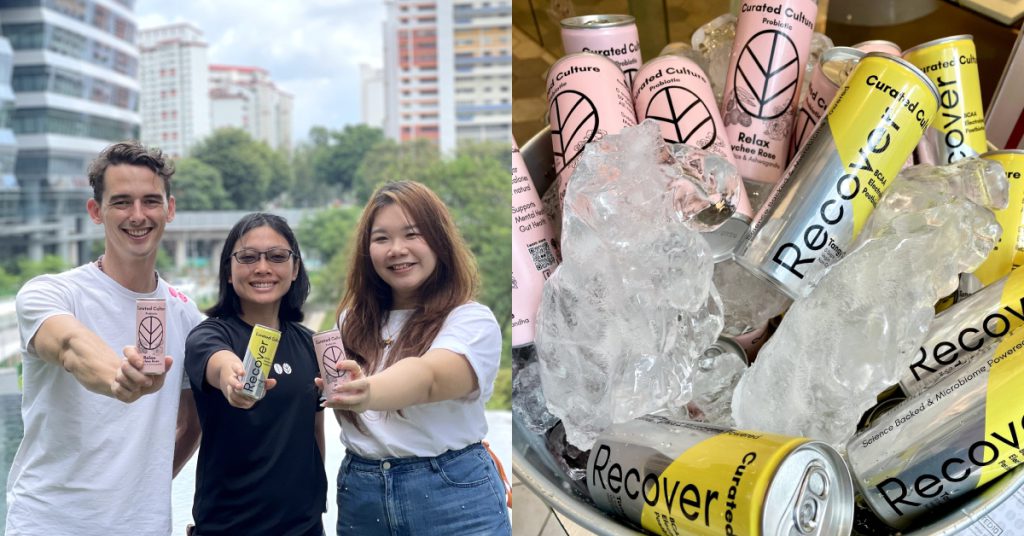
I love to eat, but there are times when my stomach bears the consequences, leaving me bloated and constipated.
While I might spare you the details of my gut issues (at least for now), I can assure you that I’m not the only person who deals with this.
In fact, it was these very experiences that pushed Christian Eviston-Putsch, Shu Wen Sew and Shermaine Heng to launch Curated Culture, a homegrown health and wellness brand that focuses on producing “functional teas” containing probiotics.
How it all started
Each founder’s journey into wellness was influenced by their personal health experiences or stories shared by loved ones, all of which played a role in shaping the brand.
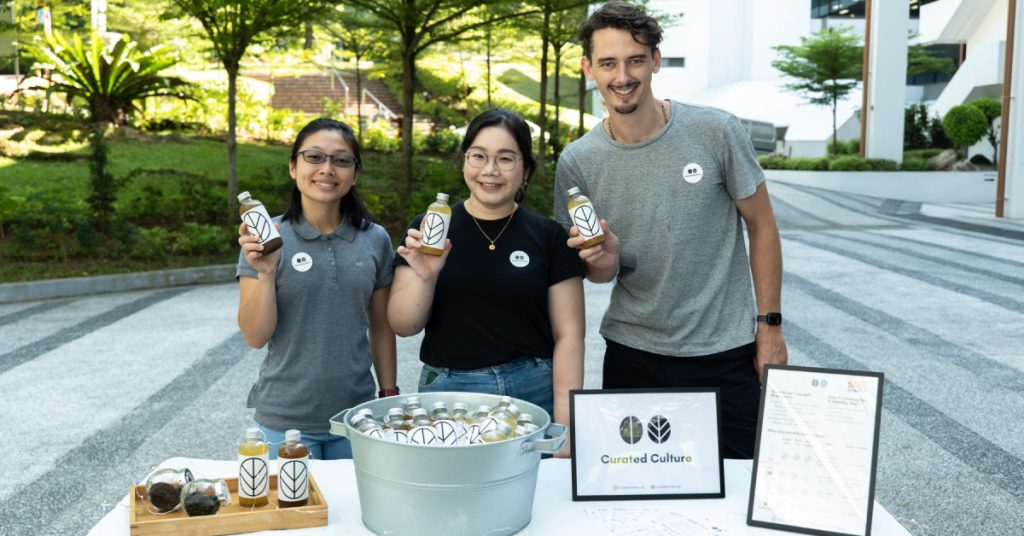
For Christian, the CEO of Curated Culture, his interest in health and biohacking began when a sudden lung infection that had him on an extended course of antibiotics led him to dive into gut health.
While antibiotics remained essential to his recovery, they would “wreak havoc” on his gut microbiome, leading him to become “obsessed” with probiotics and the science of fermentation. “What started as a personal healing journey turned into a full-blown passion,” he stated.
Determined to turn that passion into something tangible, Christian began exploring the idea of making probiotics more accessible to the mainstream market.
While pursuing his Master’s at the National University of Singapore (NUS) in March 2021, he reached out to food science professors for guidance.
That outreach led him to Shermaine and Shu Wen—trained food scientists who would go on to become Curated Culture’s COO and CTO, respectively. After just two calls, the trio decided to build a probiotic drink brand together, but what clicked for the two ladies?
Shermaine shared that she and her family regularly consume probiotic drinks, but as many of them are diabetic, and most of their choices are severely limited—they’re either “sugar-laden, artificial tasting or not effective enough.”
“I wasn’t willing to compromise on flavour for the sake of health benefits, and I believed that a great-tasting, functional probiotic drink shouldn’t be hard to find,” she added.
Shu Wen echoed the same sentiment and emphasised that gut health is often overlooked, despite it playing a crucial role in our overall well-being. With a common goal, the trio went on to materialise their goal of providing probiotic drinks that aim to be effective and tasty.
Overcoming sceptics
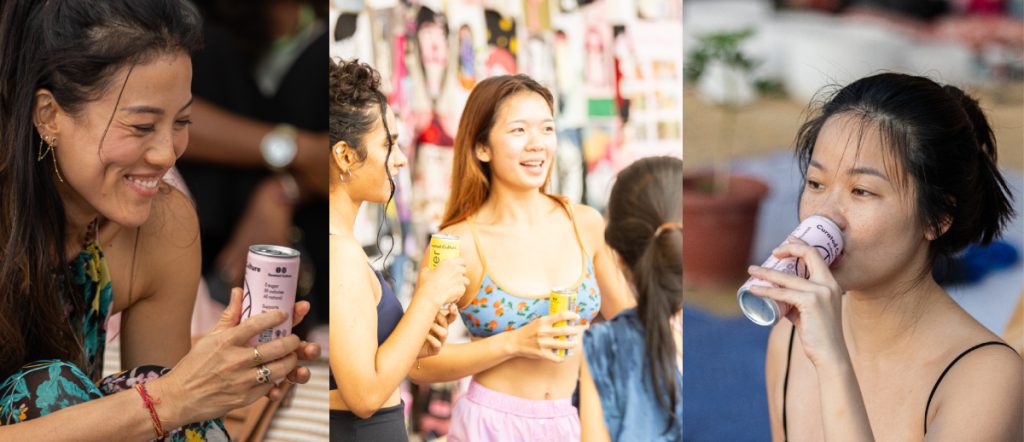
To test the waters, the founders entered the NUS Graduate Research Innovation Programme (GRIP) and, took a leap of faith to launch a presale during Christmas.
They were able to gather feedback and gauge consumer interest, which helped improve their products. Encouraged by the initial traction, the team held another presale for the Chinese New Year in 2022.
The sale saw an increased demand, spurring them to invest S$10,000 out of their own pockets to take a huge gamble by running their first production.
But how are Curated Culture’s beverages different from the many gut-friendly drinks already on the market? And more importantly, do they even work?
The health food industry has earned a bad rep for vague ingredient lists and lofty promises, which has often led to disappointment and skepticism among consumers. But Curated Culture aims to challenge that narrative.
“We ensure that the probiotics in our drinks remain effective over time,” explained Shu Wen, adding that the brand conducts “sampling and taste-testing” rounds to gather feedback and refine its formulations to meet consumer preferences.
Initially, Curated Culture found success with health enthusiasts, but the founders quickly realised that they could tap into the mainstream crowd beyond that niche—including everyday consumers who weren’t the biggest health junkies but stood to benefit “the most” from improved gut health.
“Our goal was simple: make it easy for anyone to take their first step toward a healthier life, without requiring drastic changes to their diet or routine,” stated Shermaine. “Over time, even the sceptics started embracing our products, realising that improving gut health didn’t have to be complicated or intimidating.”
This pivot turned out to be the right move, allowing Curated Culture to successfully close its first investment round. The company has also acquired angel funding and is currently raising seed funds to scale its operations.
Transitioning to retail
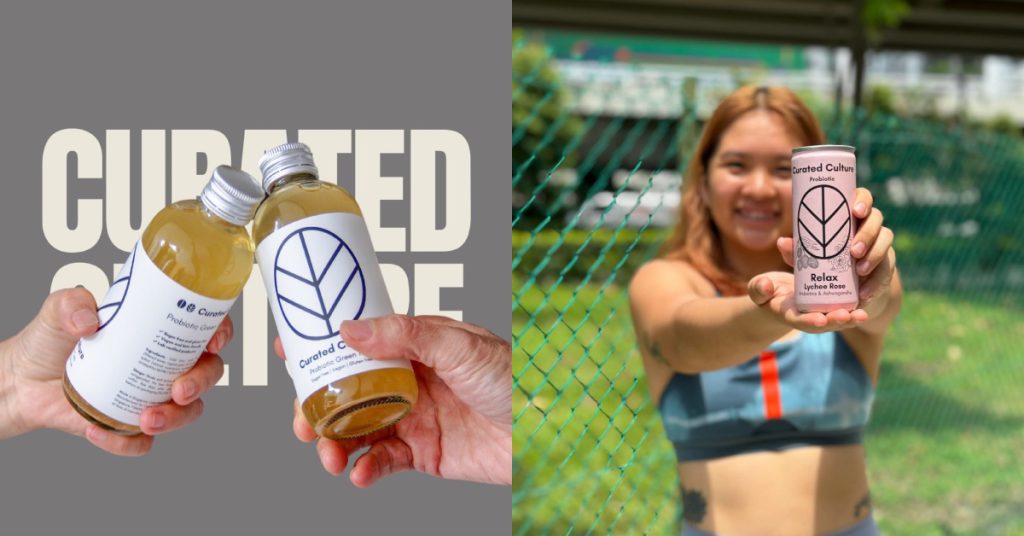
Curated Culture first began by selling its probiotic drinks through its own website, but since then, it has expanded its revenue streams to include other e-commerce platforms, such as Shopee, Lazada, RedMart, and TikTok Shop. According to Christian, this has enabled the company to fulfil over 10,000 orders and achieve a 20% month-on-month growth since launch.
Its drinks are now also sold at more than 50 stores across Singapore, including Australian restaurant chain Guzman y Gomez in Singapore as well as supermarket grocers Cold Storage and Little Farms, in a bid to become more accessible to a wider audience.
But navigating the retail industry was a new game for the trio—one that they had to learn the rules quickly. “From negotiating listings to understanding sales cycles, it was a steep learning curve,” added Christian.
Determined to grow in a competitive space, the founders took a hands-on approach, often spending hours setting up in-store displays and building relationships with store managers themselves.
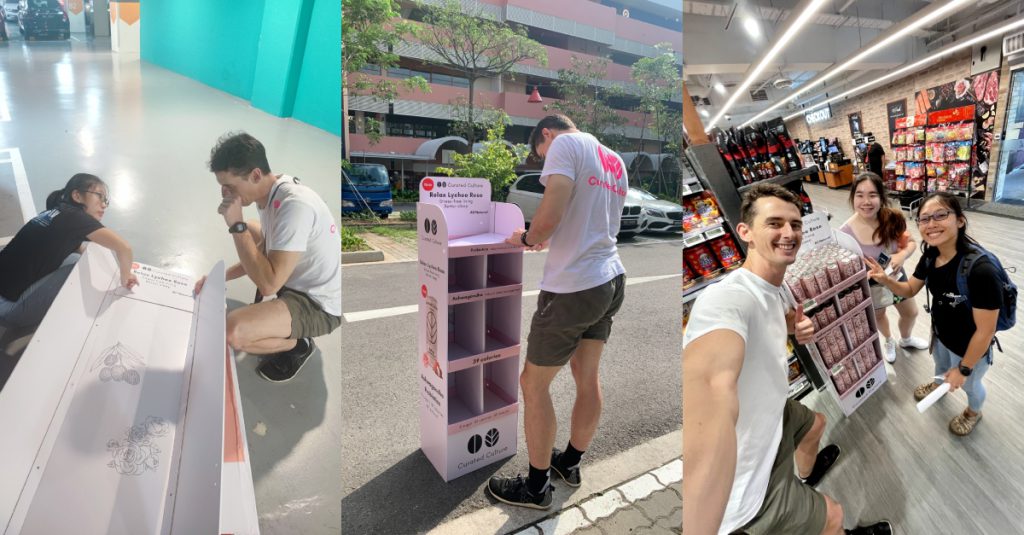
However, ensuring that their drinks were being sold wasn’t the only challenge. Shermaine shared that while they sold out at one point, their drinks weren’t being reordered by the retailers.
She explained that it’s the brand’s responsibility to ensure that shelves are stocked and that it has to maintain regular communication with retailers to ensure continuity. Adding to the challenge was the frequent turnover of category managers, which meant that the brand had to rebuild relationships with them.
“Despite these hurdles, the process helped us gain invaluable insights into retail operations and consumer behaviour,” said Shermaine.
Their continuous efforts have seem to paid off—Curated Culture has managed to build a loyal customer base, with a repeat customer rate of 40%. These milestones have also opened the doors to many brand collaborations, including Lululemon, Google, and Marina Bay Sands.
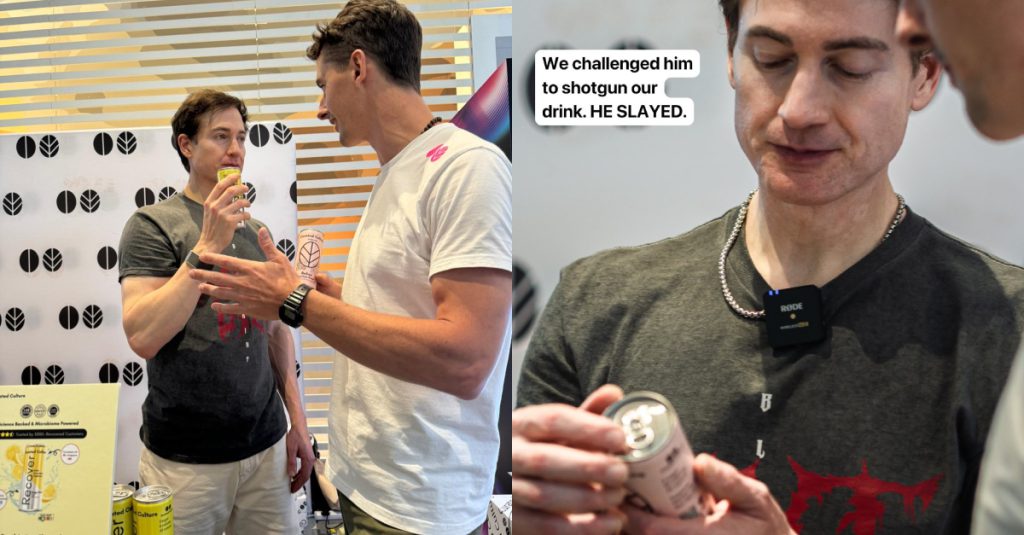
Aside from catering to the audience in Singapore, the company has also expanded into the Malaysian market and plans to further strengthen its presence in Southeast Asia.
Outside of Asia, they are also working to enter the American market, but with tariff discussions ongoing, the company is taking the time to plan its market strategy.
“By the time we ship stock over, we expect the tariff discussions to have settled. And in the long term, we plan to produce in the US,” added Christian.
Nevertheless, it seems that Curated Culture is not deterred by the impending challenges ahead, and emphasised its commitment to establish itself as the “premier health and wellness beverage brand” in the region and beyond.
Also Read: He quit the corporate life to start a S’pore snack brand selling ancient superfoods
Featured Image Credit: Curated Culture
Why do our laptops and phones feel so fragile and short-lived now? Here’s what the stats say.
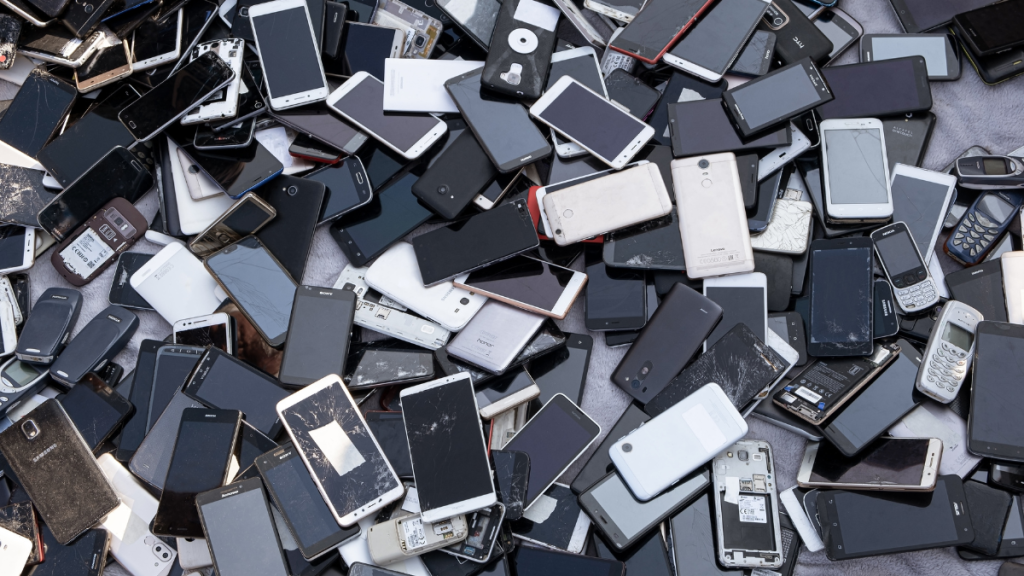
It was not too long ago when my S22+ got the dreaded green line, costing me a RM600+ repair fee and a lunch break from having to go back and forth from the repair centre.
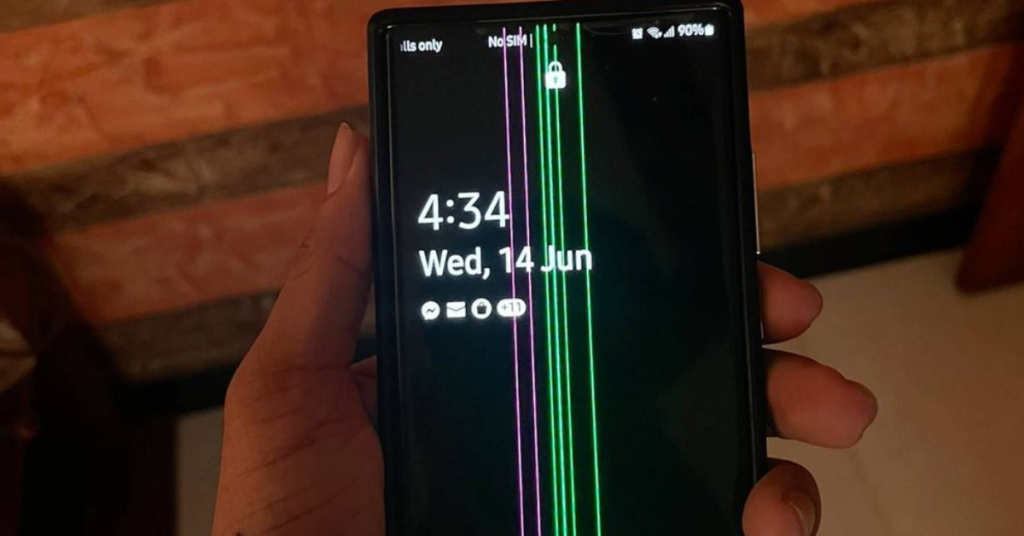
This got me thinking: Has tech always been this way? Always putting users on edge for fear of a random wire coming loose, leading to hefty repair costs or even a replacement?
Now, people often cite those “unbreakable” Nokias and Motorolas of the 2000s as a reference for the decaying lifespans of devices, but is tech really getting more fragile and shorter-lived, or is it all a matter of perspective?
Let’s take a look at the stats.
Letting the numbers talk
According to a 2022 study by the Consumer Technology Association (CTA), consumers generally expect most tech products to last about five years, with more mature devices such as TVs, desktop computers, and printers holding the highest expected lifespan among consumers, at 6.5, 6, and 5.7 years respectively.
Au contraire, more recent devices such as smartphones, smart speakers, and wireless accessories are expected to last fewer years post-purchase, at 4.8, 4.5, and 4.4 years respectively.
How does this stack up against the actual lifespans of devices, though?
| Tech | Expected Lifespan (years) | Average Lifespan (years) |
|---|---|---|
| DSLR/Mirrorless digital camera | 5.5 | 6.1 |
| TV | 6.5 | 6.1 |
| Video game console | 5.2 | 4.8 |
| Smart TV | 6.0 | 4.6 |
| Digital media streaming device | 5.3 | 3.9 |
| A/V receiver | 5.2 | 4.8 |
| Soundbar | 5.4 | 4.3 |
| Portable wireless speaker | 4.9 | 3.7 |
| Desktop computer | 5.7 | 5.1 |
| Multi-function printer | 5.6 | 4.8 |
| Laptop computer | 5.5 | 4.5 |
| Tablet | 5.1 | 4.3 |
| Cellular phone | 5.0 | 3.7 |
| Smartphone | 4.8 | 3.2 |
| Smart home products | 5.2 | 3.5 |
| Wearables | 4.3 | 3.4 |
| Headphones/earbuds | 4.4 | 3.1 |
| Gaming accessories | 4.2 | 3.7 |
Indeed, with the exception of DSLRs or mirrorless digital cameras, most consumers expect their devices to last longer than they are reported to.
That said, despite the common perception that tech lifespans are decaying over the decades, the European Environment Agency reports that the durability and repairability ratings of smart phones have increased since 2020.
As such, replacement rates of tech devices have gone down. According to Statista, smartphone upgrade cycles have steadily lengthened since 2013, going up from 2.4 to 3.7 years in 2022.
So, where does this idea of shrinking tech lifespans come from?
Taking a step back
Despite the longer replacement cycles, the European Environment Agency (EEA) notes that the consumption volume of electrical and electronic appliances has risen by more than three-fold since 2000.
Although consumption of other common consumer goods such as clothing and vehicles has also increased during that period, none have shown as much growth as consumer electronics.
“This surge is closely linked to the proliferation of mobile phones over the past two decades,” said EEA.
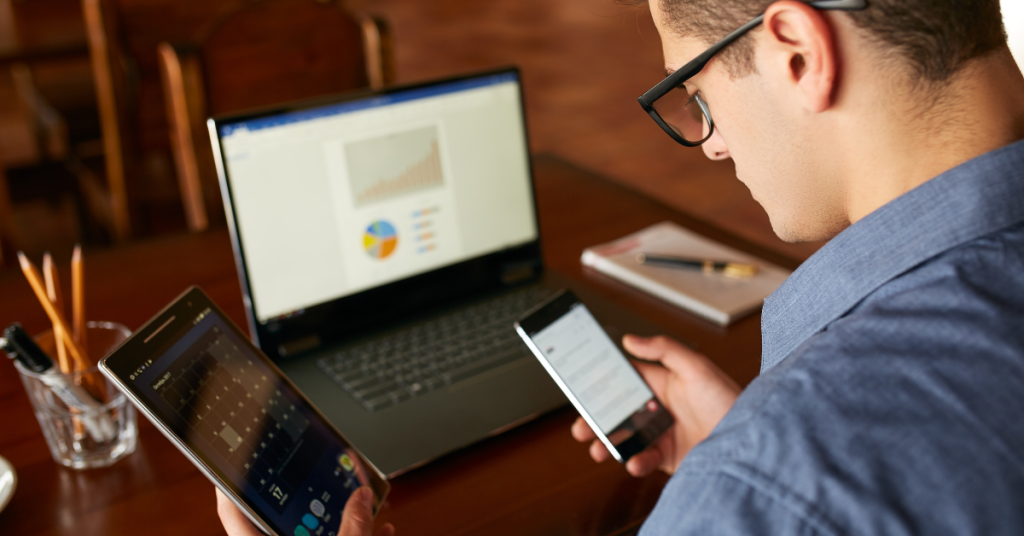
With more people opting for multiple phones, while also having to buy more devices to ease work processes and daily activities, the additional consumption of tech goods would lead to a perceived increase in tech replacement.
Further, these statistics do not take into account the second-hand market. With minimal changes between the yearly flagship devices, more people are opting to buy and sell their used devices online, adding to the perceived increase in replacement rates.
But what about planned obsolescence?
“But wouldn’t the deliberate slowing of older phones lead to higher replacement rates?”
In late-2017, Apple confirmed that it had implemented software performance controls based on battery health on older iPhone devices following reports of performance degradation on these phones.
Known as Batterygate, this led to various class action lawsuits being filed against Apple, including a fine by French consumer authorities and several U.S. states.
That said, Science Daily states that although planned obsolescence by manufacturers like Apple could contribute to device replacement rates, devices are still not being used long enough for these effects to kick in anyway.
Tamar Makov, a doctoral student at the Yale School of Forestry & Environmental Studies, states in the study that “in most cases phones are replaced when they are still working fine, so improving repairability won’t necessarily help much.”
Perhaps we should be focused on what really makes us replace phones so quickly, or we should be angry at manufacturers for making really good commercials. But it’s likely that the problem is not the hardware.
So, we good?
Although the data indicates that devices and electronic appliances are lasting longer, the sheer rise in consumption of tech goods still proves to be an environmental and sustainability concern.
According to data from the Department of Environment (DOE), Malaysia accumulated 2,459 tonnes of household electronic waste in 2021, with research findings indicating approximately 24.5 million units of e-waste in 2025.
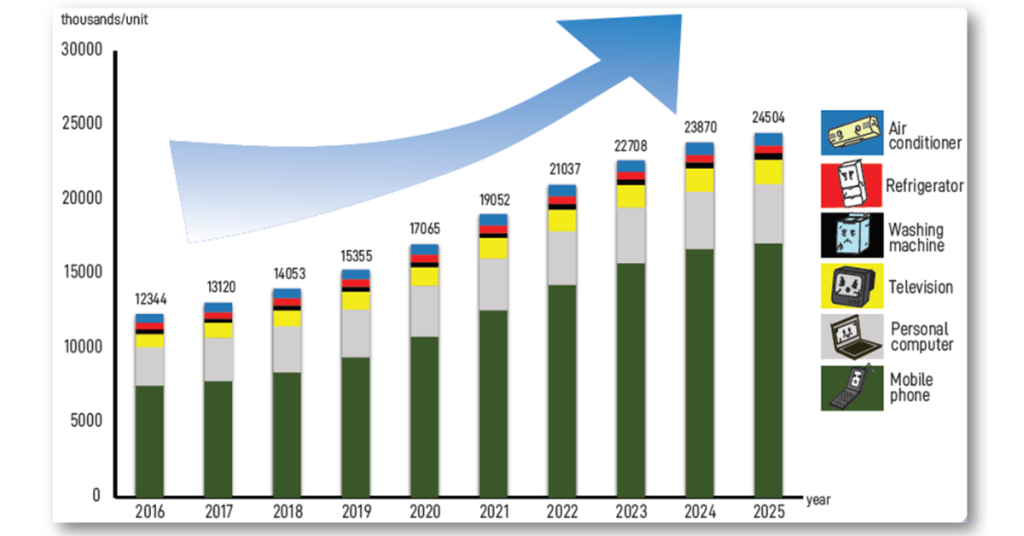
In 2020, Malaysia’s recycling rate was approximated to be 36.67%, which lags behind neighbouring countries. As reported by the DOE, the household e-waste recycling rate in the country does not exceed 25%, implying that hundreds of thousands of tonnes of e-waste end up in landfills annually.
Although the shift in consumer mentality towards a more moderate, financially savvy approach is a great start, upping our recycling practices when it comes to e-waste is still an effort we need to work on in building a sustainable future.
Also Read: Why Brisbane & Gold Coast should be M’sian travellers’ top Aussie destinations in 2025
Featured Image Credit: Images used under licence from Shutterstock
Looking to develop your film photos? Here are 8 labs in M’sia that might be worth a shot.
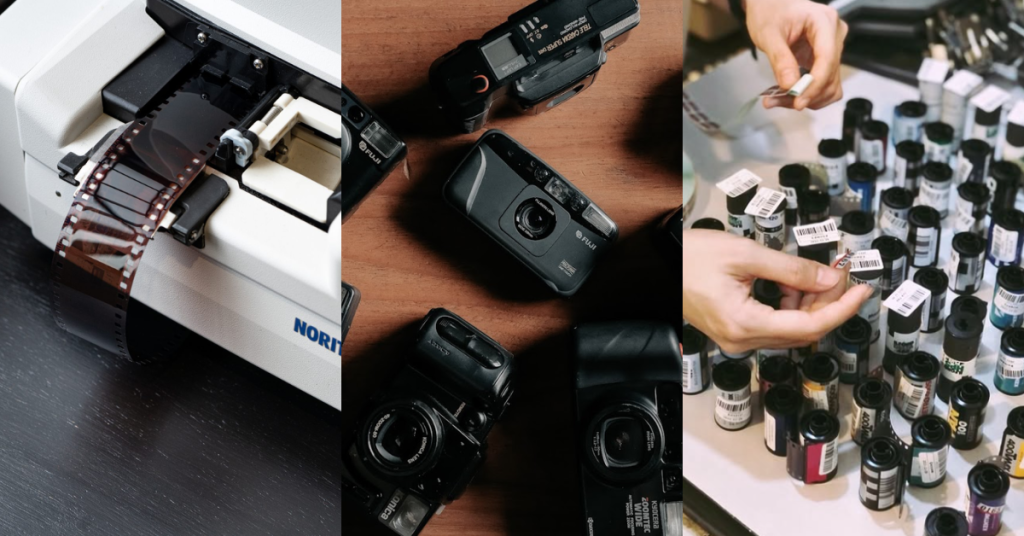
Although high-spec phone cameras and even nostalgic digital cameras are commonplace nowadays, there’s still a group of people who love and appreciate the trusty old film camera.
If you’re someone who is a part of this group (or wants to get into it), you might be looking for studios who can process your images. Here are some spots in Malaysia that can do it.
Both Johor and the Klang Valley appear to be hubs for film cameras and processing, so we’re focusing on these two regions’ offerings.
Klang Valley
1. Zontiga
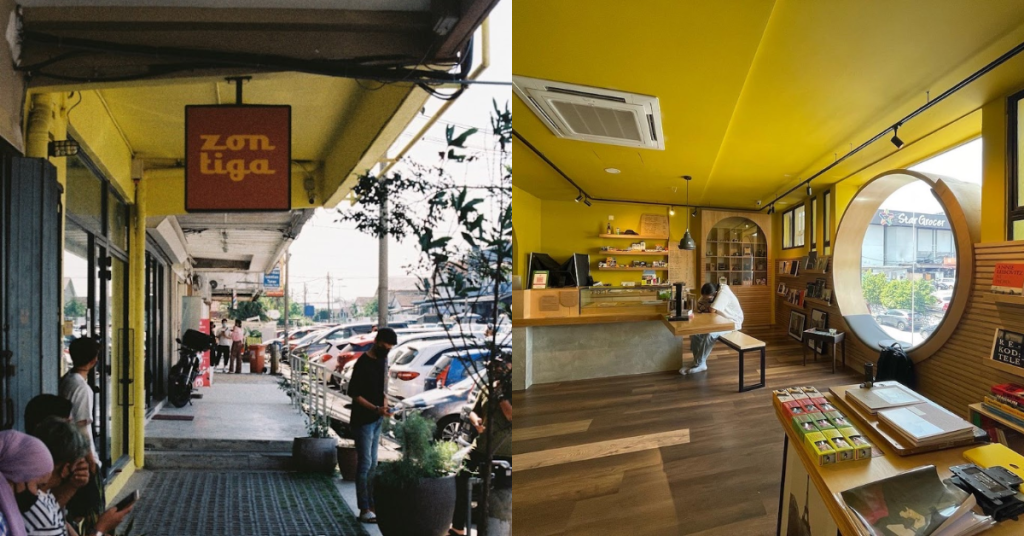
On the first floor of a Taman Paramount shop lot is Zontiga, a self-described creative hub for photography enthusiasts.
They also have an outlet on the second floor of GMBB.
Their locations are fairly accessible by public transportation, so I’ve personally frequented their stores quite often. Although they tend to tell me they need up to a week to process my film, they often send the files to me within two of their working days.
Location:
- Zontiga PJ: No.21A, Jalan 20/13, Taman Paramount, 46300 Petaling Jaya, Selangor
- Zontiga KL: GM-2-29, Level 2, GMBB, No.2, Jalan Robertson, 50150 Kuala Lumpur
Opening hours:
- Zontiga PJ: Monday to Tuesday, 12PM to 6PM; Friday, 12PM to 10PM; Saturday to Sunday, 12PM to 7PM
- Zontiga KL: Monday, by appointment; Tuesday to Sunday, 12PM to 7PM
Services & price:
| Service | Film Type | Price (RM) |
| Film Developing & Scanning | C-41 (Colour Negative), 135/120 | RM24 |
| Black & White, 135/120 | RM37 | |
| Film Developing Only | C-41 (Colour Negative), 135/120 | RM12 |
| Black & White, 135/120 | RM25 | |
| Scanning Only | Uncut Film Roll, 135/120 | RM15 |
| Film Strips, 135/120/220 | RM6 per strip | |
| 4 x 5 Sheet Film, 4 x 5 | RM12 per sheet | |
| Mounted Slide Film, Slide | RM6 per slide |
Turnaround time: Within seven days for their PJ location and 10 days for their KL branch
Contact: info@zontiga.com
2. Darkroom8
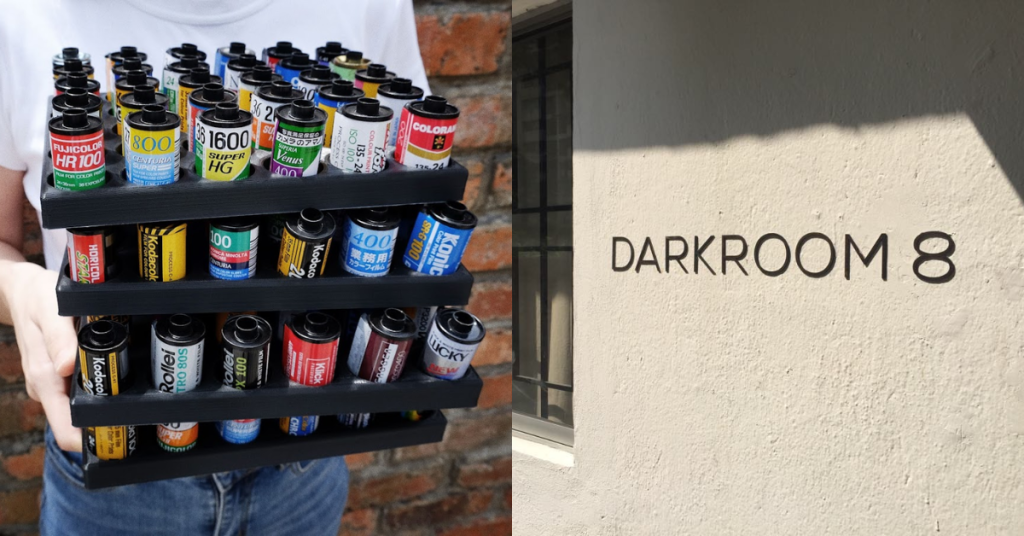
A photo lab in KL, Darkroom8 offers film developing and scanning, photo printing, as well as fine art printing services.
They also offer film delivery services, so if you live further away, you can still send your films to them to develop and process.
Location: 62, Jalan Galian, Taman Miharja, 55200 Kuala Lumpur, Wilayah Persekutuan Kuala Lumpur
Opening hours: Monday to Sunday, 12PM to 6PM
Services and price:
| Film Processing & Film Scanning | Format | Price |
| C41 Film Processing and Scanning | 135 / 120 | RM16.80 |
| Black & White Film Processing and Scanning | 135 / 120 | RM16.80 |
| ECN2 Film Processing and Scanning | 135 / 120 | RM20 |
| E6 Reversal Processing and Scanning | 135 / 120 | RM50 |
| Non-standard 35 mm frame | 135 | +RM10 |
Turnaround time: Same day delivery possible for C41 Colour Negative Film, and three days for Black & White Negative Film
Contact: Instagram
3. Bang Bang Geng
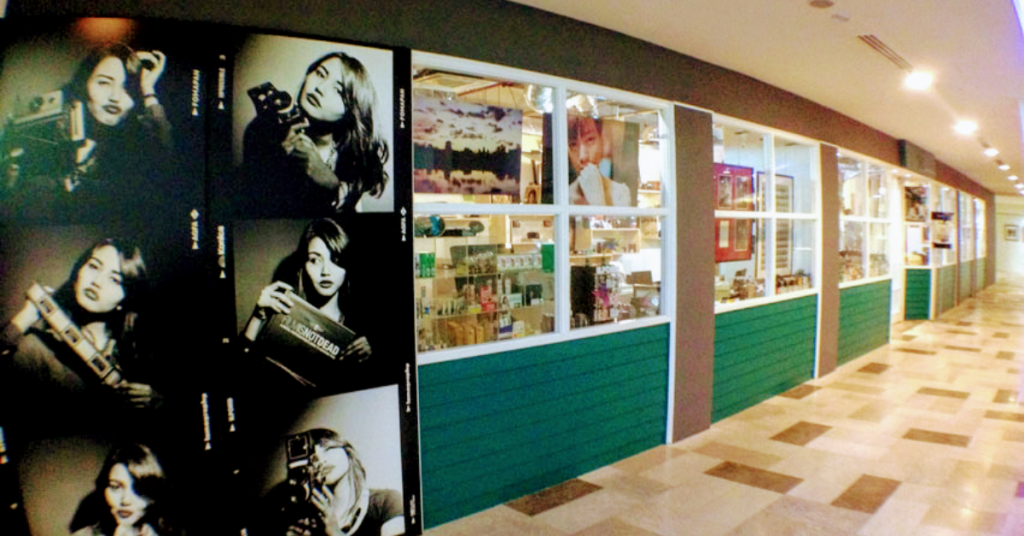
Founded in 2013, Bang Bang Geng is a notable film shop in Klang Valley, offering all sorts of products for photography enthusiasts, especially those who prefer things analogue.
The Publika shop also offers some photo processing services for film cameras.
Location: Lot 15-20, level G1, Publika Shopping Gallery, Jln Dutamas 1, Solaris Dutamas, 50480 Kuala Lumpur
Opening hours: Monday to Sunday, 11AM to 8PM
Services and pricing:
- C-41 colour film: RM25/roll
- Black & white film: RM30/rol
Turnaround time: Two to five days
Contact: 03-6211 9025
4. Saujana Film Lab
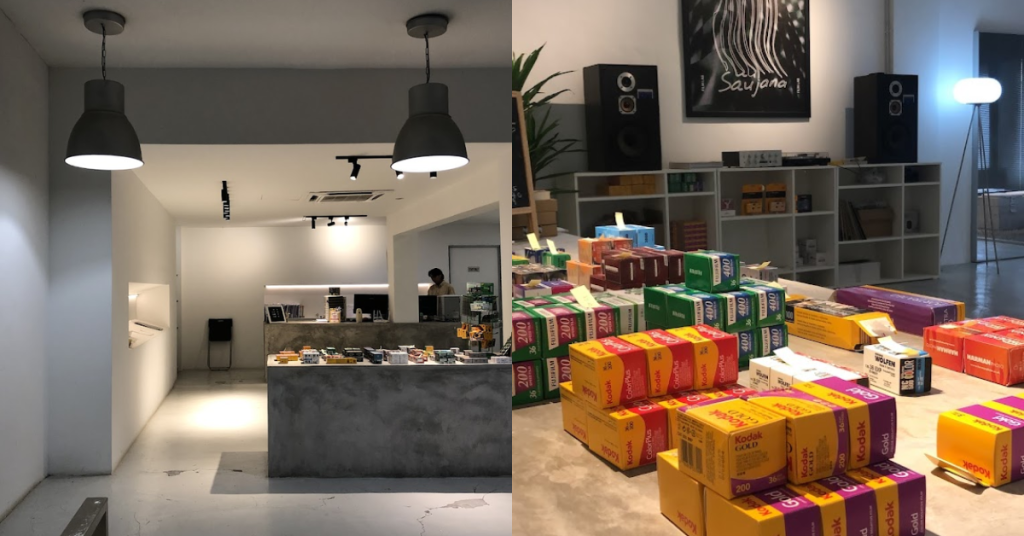
Located in Imbi, Saujana Film Lab is all about speedy service. They’re able to process your colour films in just an hour.
As for other kinds of processing, they can also complete it within a day.
Location: 16, Lorong 1/77a, lmbi, 2nd Floor, 55100 Kuala Lumpur, Wilayah Persekutuan Kuala Lumpur
Opening hours: Monday to Thursday, Saturday to Sunday, 11AM to 6PM
Services and pricing:
| Developing and Scan | C-41/Colour | RM15 |
| Black and white | RM17 | |
| ECN2 Colour | RM18 | |
| ECN2 Black and white | RM18 | |
| Developing only | C-41/Colour | RM10 |
| Black and white | RM12 | |
| ECN2 Colour | RM12 | |
| ECN2 Black and white | RM12 | |
| Scan only | Any type | RM10 |
Turnaround time: One hour to one day
Contact: 011-5934 8334
5. Film Lab
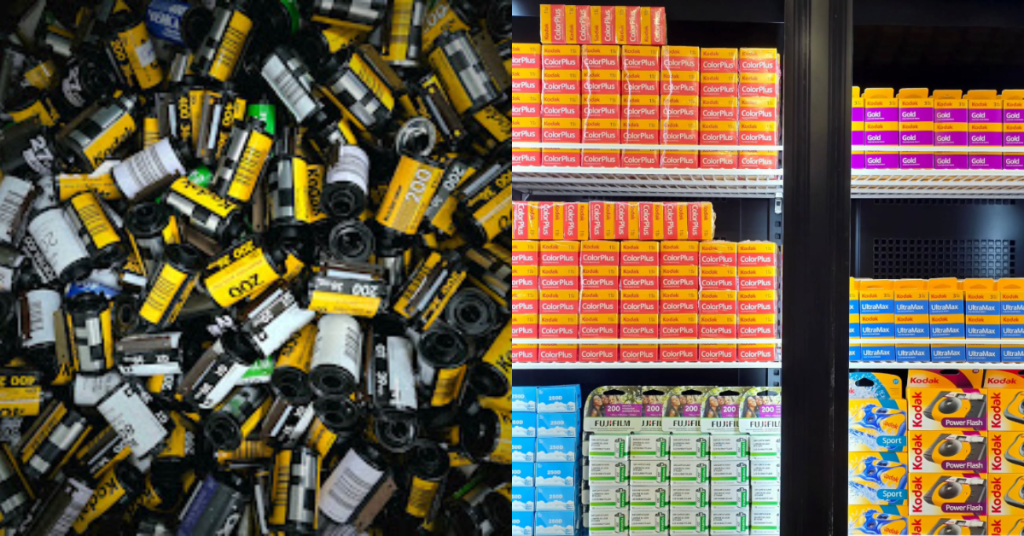
Describing themselves as a film processing expert, Film Lab is a authorised Kodak dealer in Malaysia that offers a range of film processing services.
You can ask them to ship back your negatives or opt not to.
Location: Lot 9, Jalan 2/118B, Desa Tun Razak, 56000 Cheras, Wilayah Persekutuan Kuala Lumpur
Opening hours: Monday to Friday, 9:30AM to 5PM; Saturday to 9:30PM to 12:30PM
Services and pricing:
| Film Format & Type | Develop & Scan (35 mm / 120 Medium Format) |
| Colour Negative (C41) | RM14.80 |
| Single Use Disposable Camera (Colour C41) | RM14.80 |
| Black & White Negative | RM18.00 |
| ECN2 Motion Colour Film | RM16.80 |
Turnaround time: Same day or one working day; three to five working days for black and white negatives
Contact: 019-931 5270
Johor
1. FilmNeverDie.Asia
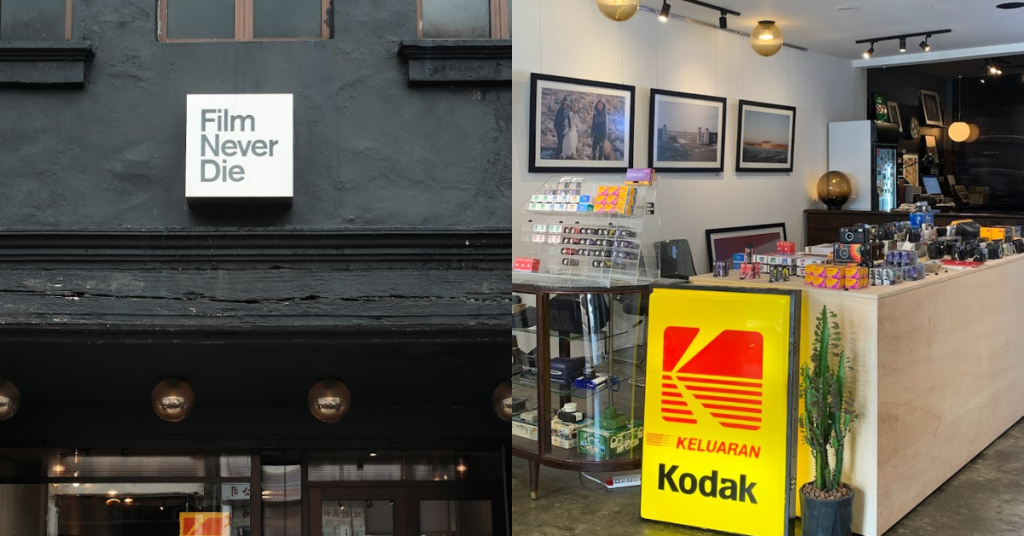
FilmNeverDie is a film camera shop in Batu Pahat, Johor.
For those who find their location a bit out of the way, they have a variety of film drop-off locations in Johor and KL. They also take mail-ins.
Location: 110, Jln Rahmat, Kampung Pegawai, 83000 Batu Pahat, Johor Darul Ta’zim
Opening hours: Monday to Tuesday, Thursday to Sunday, 11AM to 6PM
Services and pricing:
| Film Format & Type (35 mm & 120 film) | Develop Only | Develop & Scan (35 mm) |
| Colour Negative (C-41) | RM12 | RM18 |
| Black and White | RM18 | RM23 |
| Slide/Reversal (E-6) | RM40 | RM45 |
| Motion Film (ECN-2) | RM20 | RM25 |
Turnaround time: Colour and black and white processing will take from two days to seven days, though other services can take up to two months
Contact: 014-6197916
2. The Duckroom
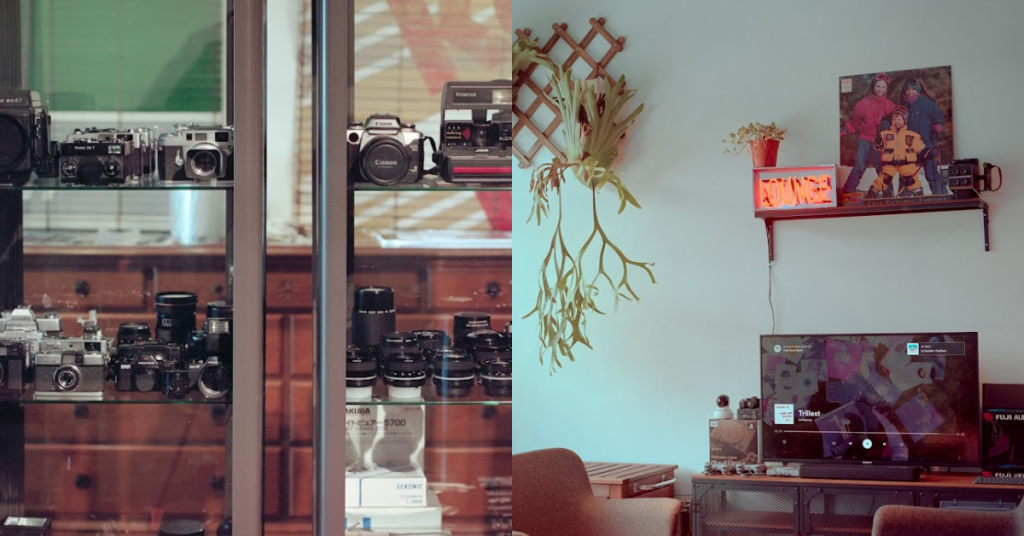
A pioneering film lab in Johor, The Duckroom seeks to illustrate how “Film is Not Dead.”
It’s a welcoming spot that aims to create a safe space for likeminded people and sells a variety of equipment.
Location: F-03-08, Level 3, Blok F, Komersial Southkey Mozek, Persiaran Southkey 1, 80150 Johor Bahru, Johor
Opening hours: Monday to Saturday, 10.30AM to 6.30PM
Services and pricing:
| Film Format & Type (35 mm and 120 film) | Develop Only | Develop & Scan |
| Colour Negative (C-41) | RM15 | RM20 |
| Black and White | RM18 | RM23 |
| Motion Film (ECN-2) | RM20 | RM25 |
| E6 Colour Reversal (slide) | RM40 | RM45 |
Turnaround time: One to three days for C-41, black and white, and motion film processing; up to six weeks for slide processing
Contact: 019-7893626 | lab@theduckroom.com
3. The Black Hole Lab
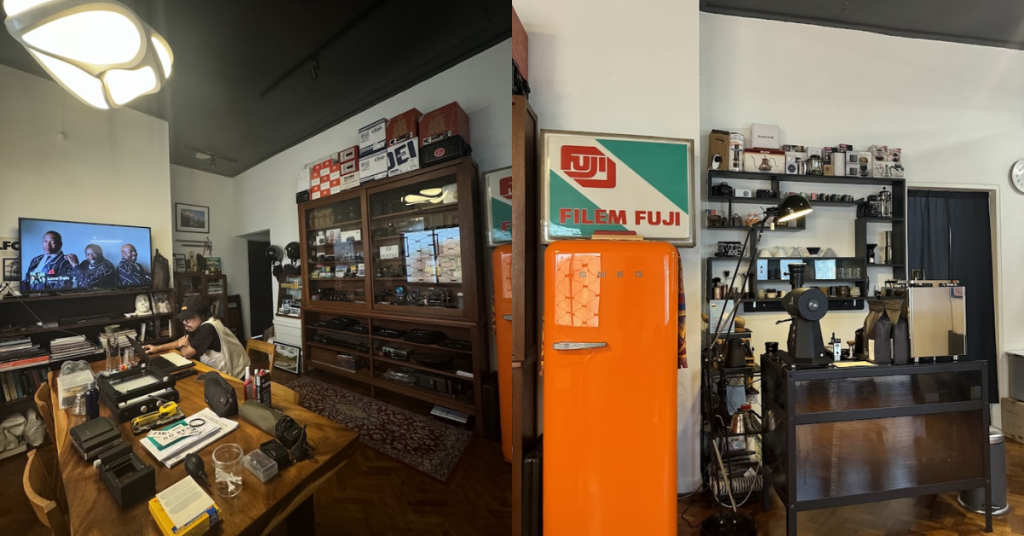
For Brendon Leong, film photography looked like a passing fad until he fell into the rabbit hole—or should we say blackhole?
Originally more of a digital photographer, Brendon went on to start his very own film lab. But before starting The Black Hole Lab, he was actually also involved in the creation of The Duckroom.
Today, the two entities are operated separately, but both seek to uplift and contribute to the film community in Johor and beyond.
Location: 9, Jalan Bijaksana, Taman Abad, 80250 Johor Bahru, Johor Darul Ta’zim
Opening hours: Monday, Wednesday to Sunday, 12PM to 6PM
Services and pricing:
| Film Format & Type (35 mm& 120mm film) | Develop Only | Develop & Scan |
| Colour Negative (C-41) | RM13 | RM18 |
| Black and White | RM15 | RM20 |
| Motion Film (ECN-2) | RM22 | RM25 |
| E6 Colour Reversal (slide) | RM35 | RM50 |
Turnaround time: One to two working days for colour processing, around seven days for black and white processing and motion film. Slide processing is subject to change.
Contact: 012-260 8760
- Read other articles we’ve written about Malaysian startups here.
Also Read: Why Brisbane & Gold Coast should be M’sian travellers’ top Aussie destinations in 2025
Featured Image Credit: The Black Hole Lab/ FilmNeverDie.Asia / Darkroom8
We had the OPPO-rtunity to test the slimmest foldable phone on the market priced at RM7,999
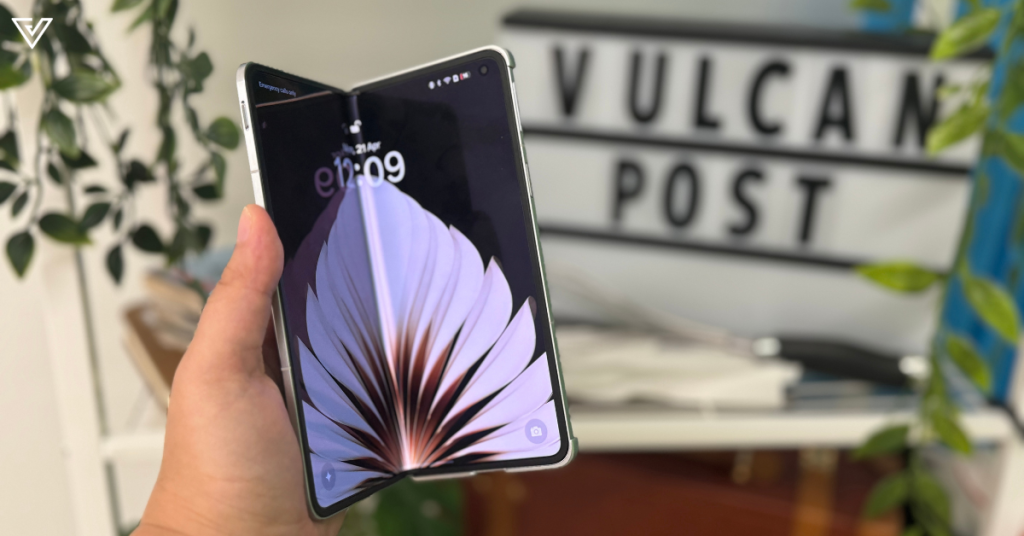
It’s as light as a coffee cup.
Given, this is a very vague statement, since that could refer to a 20-ounce Venti latte, or just a half-empty paper to-go cup. But that’s exactly how OPPO describes their latest Find N5 foldable.
They also describe it to be as slim as a pencil, at 8.93 mm. That would make it essentially the thinnest foldable on the market.
So, what does that mean for the average user?
Serving visually
We got the phone in a beautifully elegant Misty White colourway. It’s not just a simple old white shade, though—upon closer inspection, there’s a lovely textured finish with subtle patterns all over.
There’s also Cosmic Black which offers a smoother, silky surface.
The phone also came with its very own case. I appreciate that you don’t have to pay extra for it (cough, cough) since no one else is really making these super specific phone cases with magnetic spines that slide into place when you fold and unfold the phone.
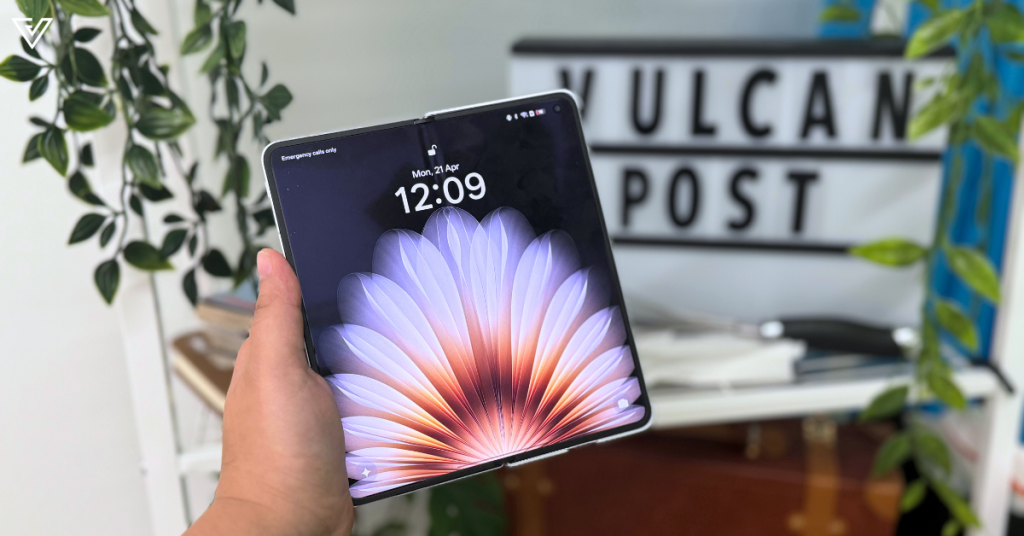
But regarding the physicality of the phone, the rear camera module is pretty thick, so the phone can be a bit wobbly sometimes when you set it down screen up. It also somewhat feels unbalanced when you have it unfolded as well, but I do think it’s a matter of getting used to.
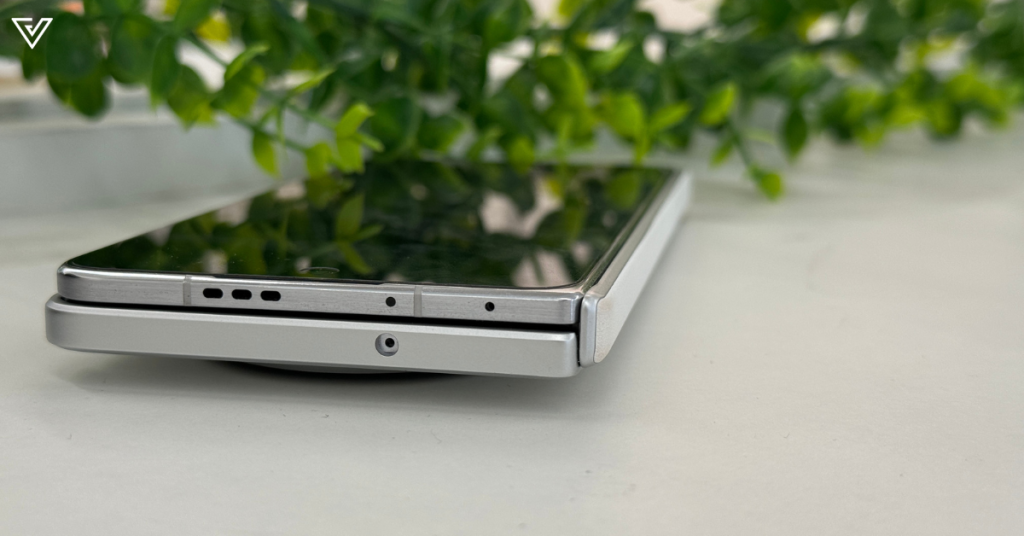
Real real estate
Let’s talk about the front screen first. When it’s folded up, it feels just like any other phone, fitting easily in one hand. With a 6.62-inch screen and a ratio of 20.7:9, it really presents itself as a normal bar phone.
When unfolded, though, the screen expands to 8.12 inches diagonally. And the thickness? A shocking 4.21mm.
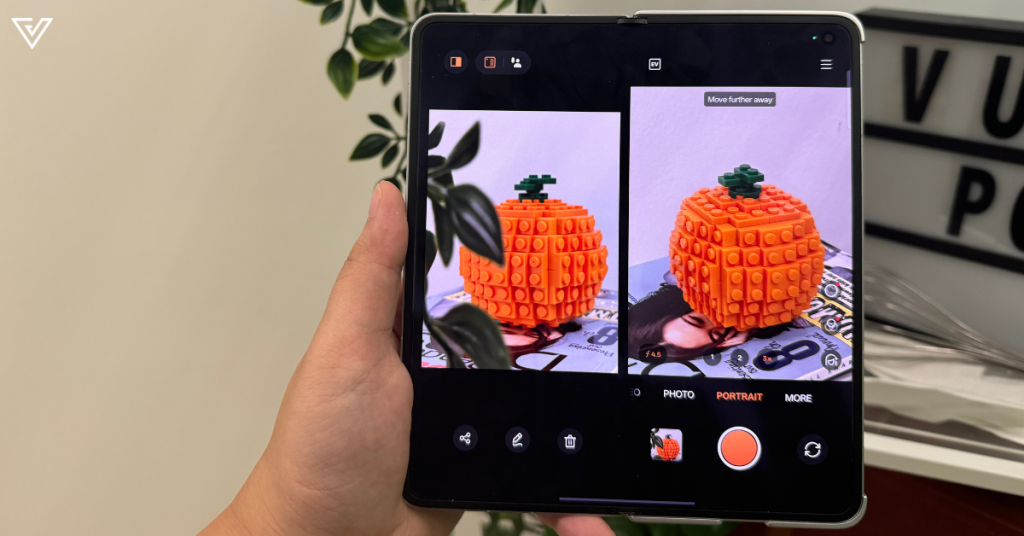
The LTPO screen has a dynamic refresh rate of 1-120Hz. For the cover screen, there is a peak brightness of 2450 nits and a high resolution of 2616 × 1140. Inside, that would be 2,100 nits and 2480 × 2248 high resolution.
In any case, this phone is always crisp and colourful, even when outdoors. And when you’re in the dark, there’s something called Bedtime Mode to reduce blue light exposure.
Hinging on durability
When it comes to folds, we can’t not talk about the hinges.
The OPPO Find N5 uses something called a Titanium Alloy Flexion Hinge, comprising a 3D-printed Titanium Alloy Casing and Wing Plate, resulting in a 26% reduction in thickness.
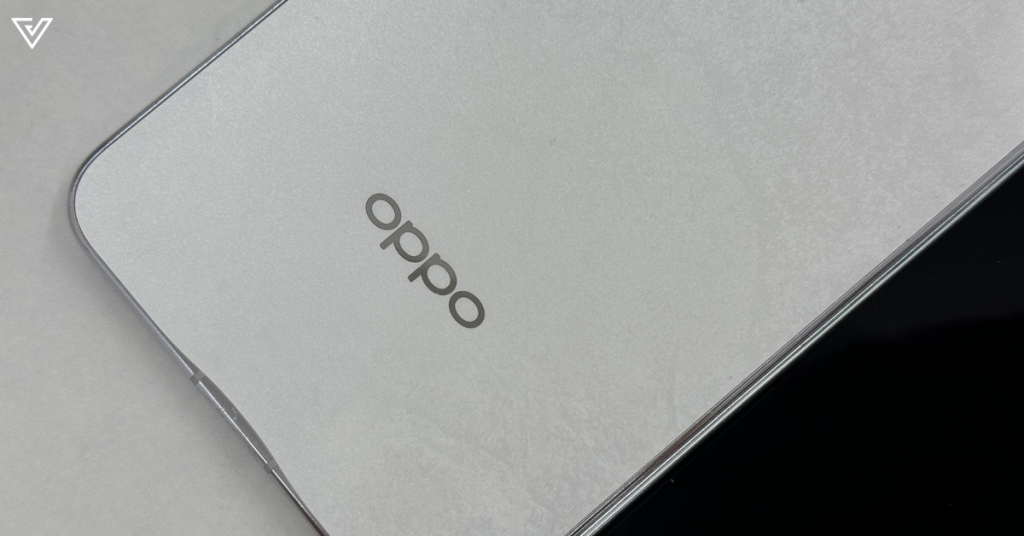
It’s also reinforced with industry-leading 2,200 MPa Ultra-High-Strength steel bits.
So what does that all mean? Well, I can’t personally speak to the durability, but I do think that the hinges feel buttery smooth and perfectly easy to use.
The phone is also framed with aircraft-grade 7-series Aluminium Alloy, boasting strength and elongation.
As for the inner screen, OPPO is using a UTG (ultra thin glass) plus dual layers of anti-impact films, which is all supposed to protect against drops and daily wear while maintaining a sleek, flat surface.
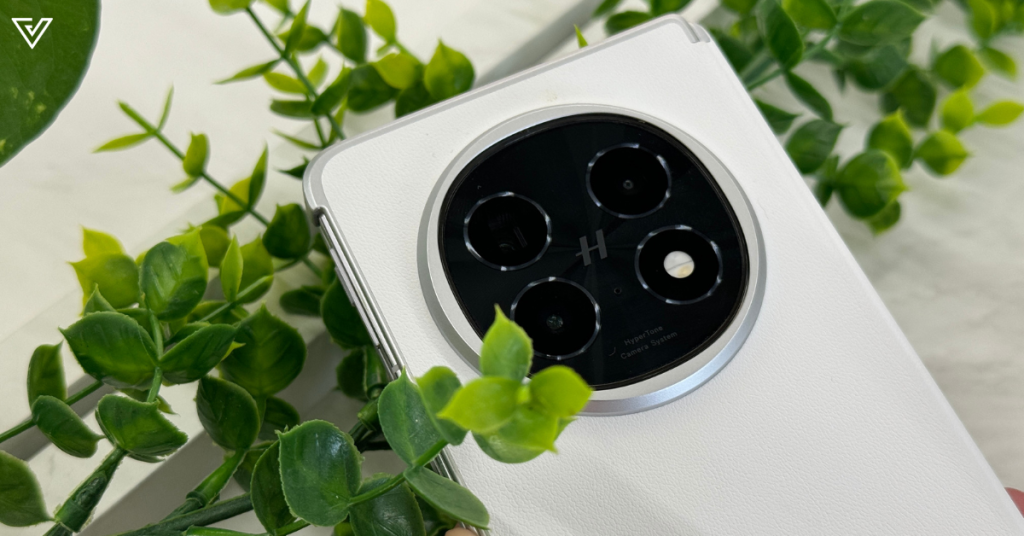
Compared to their previous fold models, the Find N5 has 30% improvement in bending resistance and 70% stronger impact resistance, the brand claims.
On the topic of durability, I’m also excited, as a clumsy person, to report that the phone is waterproof, meeting the conditions for IPX6, IPX8, and IPX9 ratings. This somewhat surprised me, considering the assumed fragility of foldables, especially when they come this thin.
What about the photography?
Co-developed with Hasselblad, it’s not surprising that the photography on this bad boy is pretty impressive.
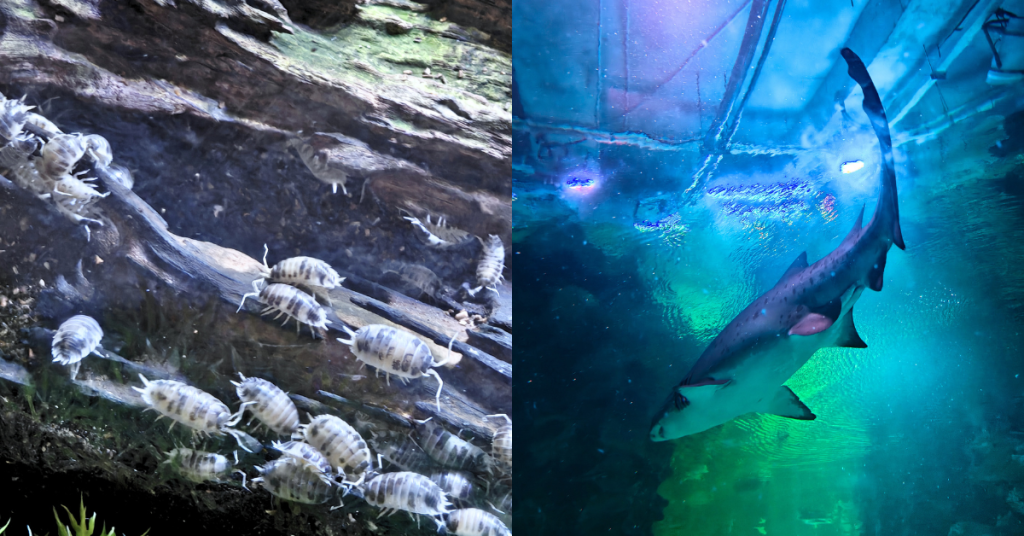
The question isn’t whether it’s good, it’s how good?
The wide angle camera is 50MP, the telephoto is also 50MP, and the ultra-wide is 8MP. There are two front cameras—one on the cover screen, the other inside. Both are also 8MP.
The ultra-wide and front cameras are a little disappointing, I must say. I was hoping for at least 12MP for these cameras.
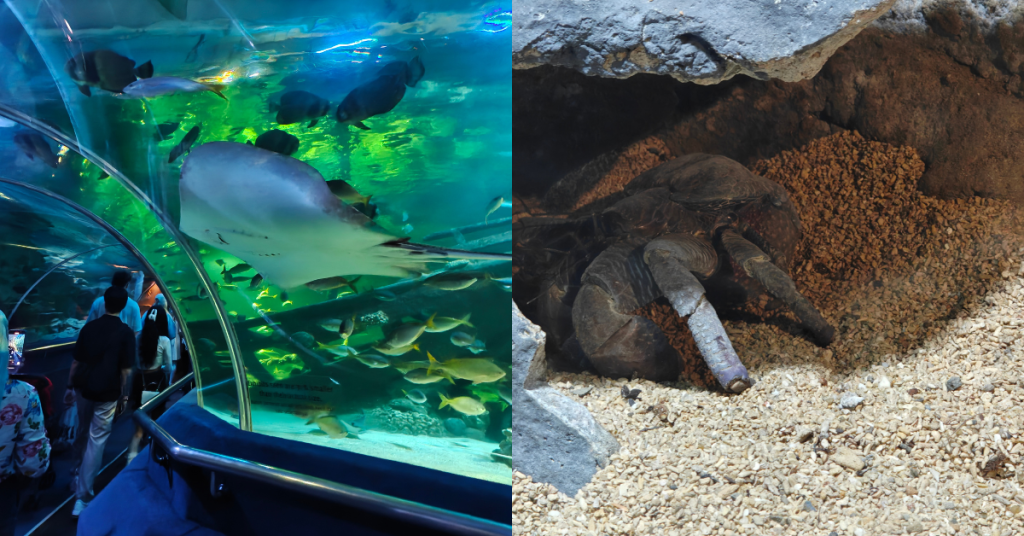
Fascinatingly, the selfie camera inside is super offset to the right upper corner. It’s a bizarre placement, but it doesn’t really detract much from the selfie experience, save for a more diverted eyeline if you, like most, stare at yourself when snapping pics. Narcissists, am I right?
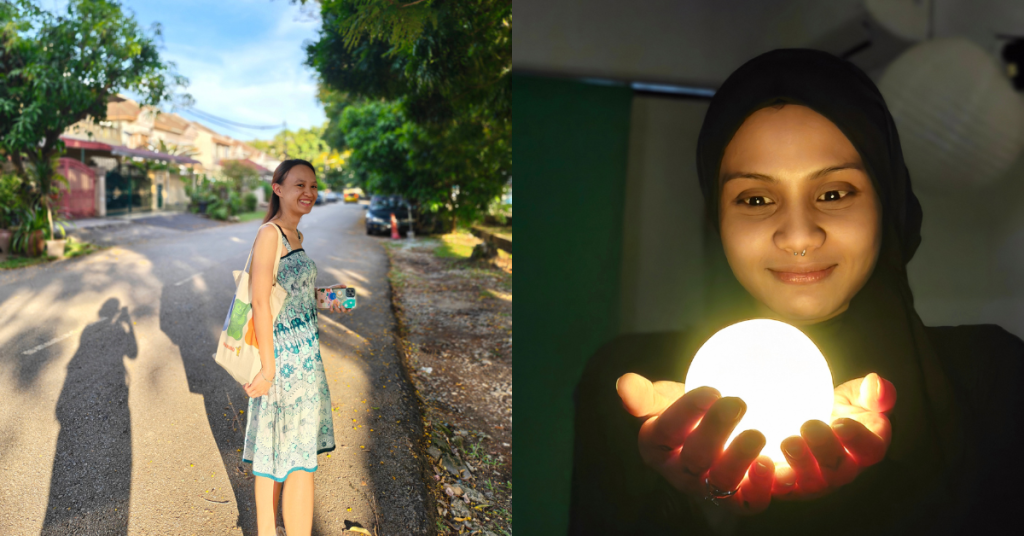
But more than the hardware of the camera, it’s the processing that really shines. I find portraits in particular to look great on OPPO phones. It doesn’t do the best in terms of details when there are over-exposed light sources, but it does well both indoors and out.
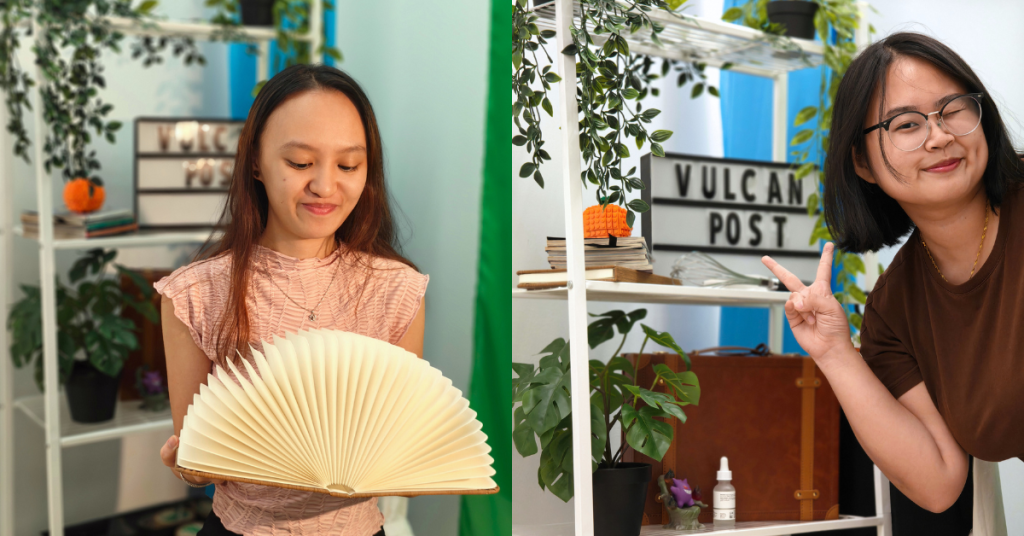
But when it comes to some more action shots, it’s not the most crisp.
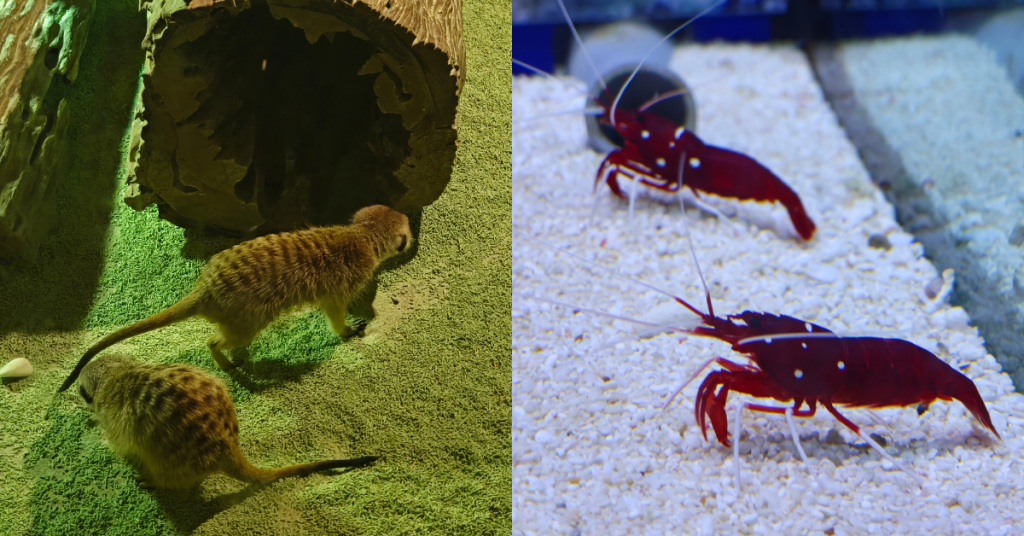
There’s lots of stuff you can edit in post as well, as OPPO offers a range of AI tools like the AI Clarify Enhancer, AI Eraser, AI Unblur, and AI Reflection Remover.
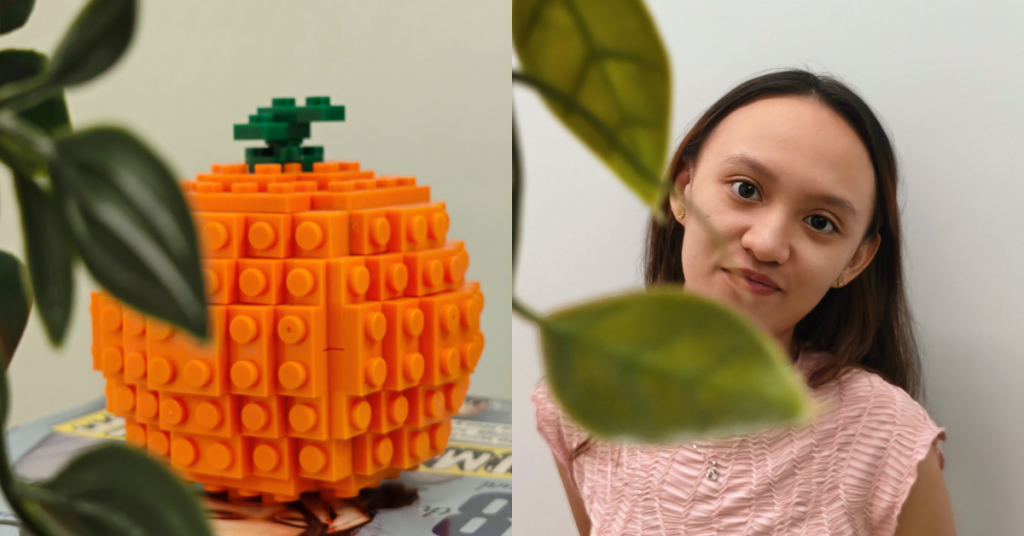
Reliable performance
Under the hood, the phone is fitted with the seven-core Qualcomm® Oryon™ CPU@4.32GHz, with a Adreno™ 830@1100MHz GPU.
Gaming on the phone is smooth, and I never noticed it getting too warm. Perhaps the surface area also helps cool down the phone faster? The size and ratio of the screen does make it a bit awkward to play certain games, but for the most part, it works just fine.
Interestingly, the phone also offers seamless Mac connection, allowing users to easily search, access, edit, and sync files on their Mac remotely.
Essentially, OPPO believes that it can turn your phone into a “mini-PC for unparalleled productivity.”
I did try working on it, laptop style, but unfortunately, it’s just not very ergonomically sound.
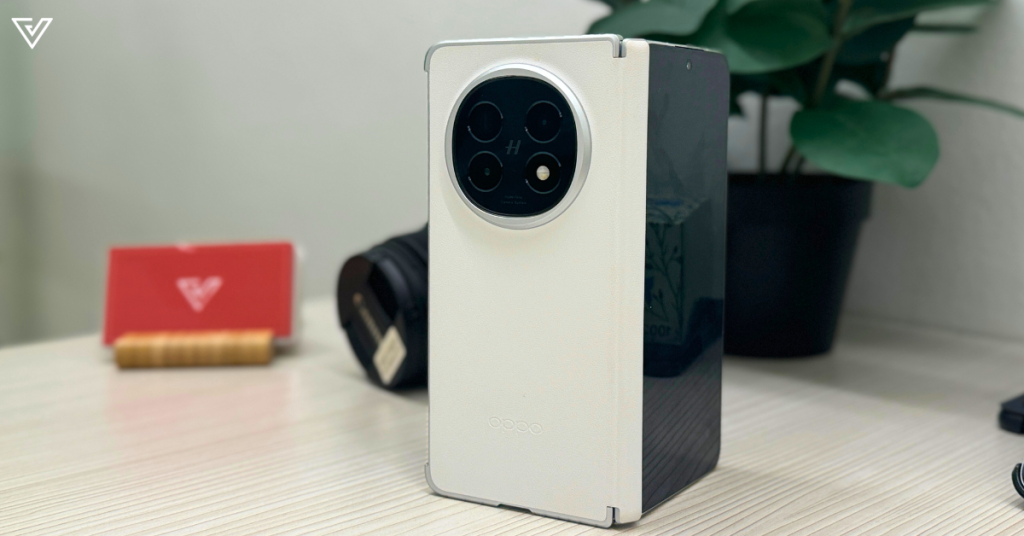
Sure, it’s possible, but you do need to lean it against something because it will keep toppling (trust me). On top of that, the angle of your neck just isn’t the best when you’re working like that for a longer period of time.
On the topic of “long periods of time,” I did find the battery life to be somewhat decent, though nothing impressive. I managed to drain the battery a few times, bringing me to the Super Power Saving Mode, which limits your phone’s functions.
That’s why I was surprised to find out that the phone actually has a huge 5,600mAh battery, which is super up there in terms of foldable phones. But I guess bigger screen, bigger battery needed.
Fine, I’ll talk about the AI
As you can tell, I’m not really someone who enjoys maximising AI features on a phone. Call me old school or dated. It’s just not something I really reach for or need.
But for people who do leverage those AI tools on their mobile devices, you’d be happy to know that the OPPO Find N5 does have AI Search, AI Assistant for Documents, AI Call Summary, and even an AI Translate Assistant. Dare I call it a Galaxy AI competitor?
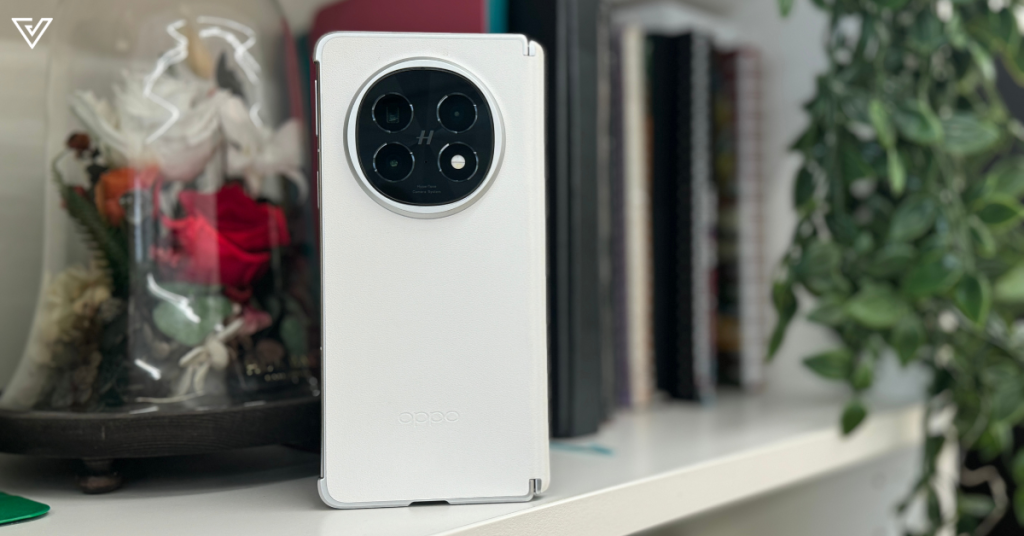
Of course, there’s also the whole suite of Google smart features like Circle to Search and the Gemini app.
There’s also something called the AI LinkBoost, used to improve network connectivity, particularly in challenging environments.
The verdict
It’s all you could want in a phone, in a foldable.
But what’s the price?
Well, for all its frills and innovation, the OPPO Find N5 will set you back RM7,999—comparable to the likes of Samsung Z Fold6 and the Huawei Mate X6.
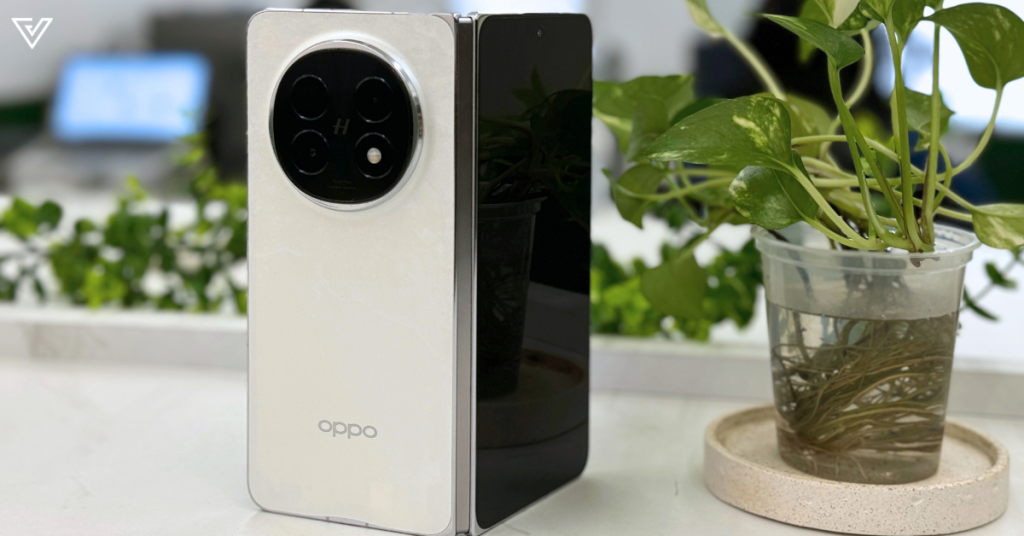
I feel like you do pay for what you get, but because of the steep pricing, it does seem like a bit of a stretch for the average person.
If you’re someone who loves tech and products that push boundaries, though, you’ll find (pun intended) that the Find N5 might have just what you need, so long as you’re willing to pay nearly RM8K for it.
VP Verdict is a series where we personally try and test out products, services, fads, and apps. Want to suggest something else for us to try? Leave a comment here or send the suggestion to our Facebook page.
Also Read: This global real estate firm is expanding to KL to help local agents achieve their ambitions

